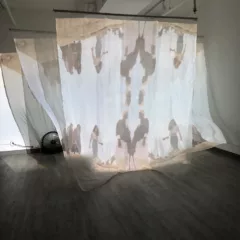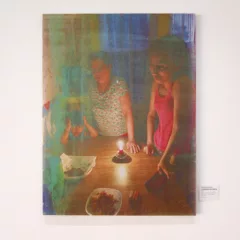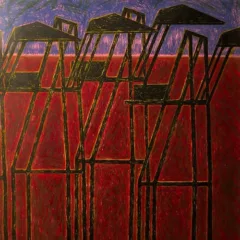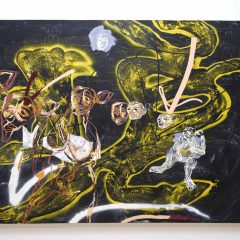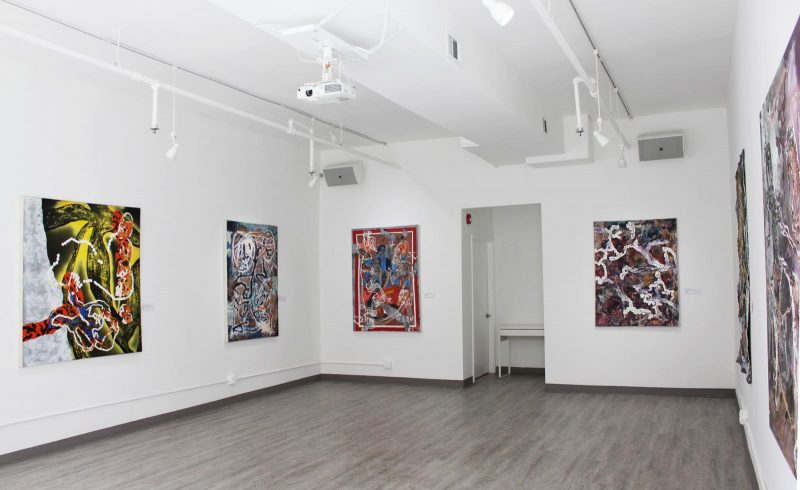
In an era of intense social and political rhetoric, there is nothing more redemptive, I believe, than getting lost in the deep and careful observation of a work of art. Letting the eyes wander around a painting for example, lingering on its details, responding to its texture is a lofty form of escapism, increasingly difficult to experience these days in a world of constant mediated inputs.
Shwarga Bhattacharjee’s six large paintings at Twelve Gates Arts provide just the perfect opportunity to immerse yourself. Although the work is both deeply personal and rooted in the artist’s cultural and political experiences, it is the vibrant materiality of the paintings which first draws you in.
Take “Clue You Missed Along the Way,” the first piece you encounter upon entering the gallery. Several striking textures coexist within the painting, from airbrush-like smooth passages and what evokes opaque white tracing paper, to linear shapes with crosshatches, thick impasto dots, and impasto’d skulls in white and orange, and lines that seem scraped and then covered up, the work suggests a map, perhaps redrawn time and again. In fact, Bhattacharjee’s paintings are both abstract historical landscapes and topographic maps. Although roughly rendered, the skulls are unambiguously the only figurative elements of the composition.
What emerges is the subtle recurrence of patterns, shapes, elements, color combinations and techniques through most of the paintings on view. Another, and bigger skull is visible in “One pot, One body.” This time, it is attached to a large four-legged creature. More skulls, recognizable by their pronounced dentitions, emerge in “History in My Land.”
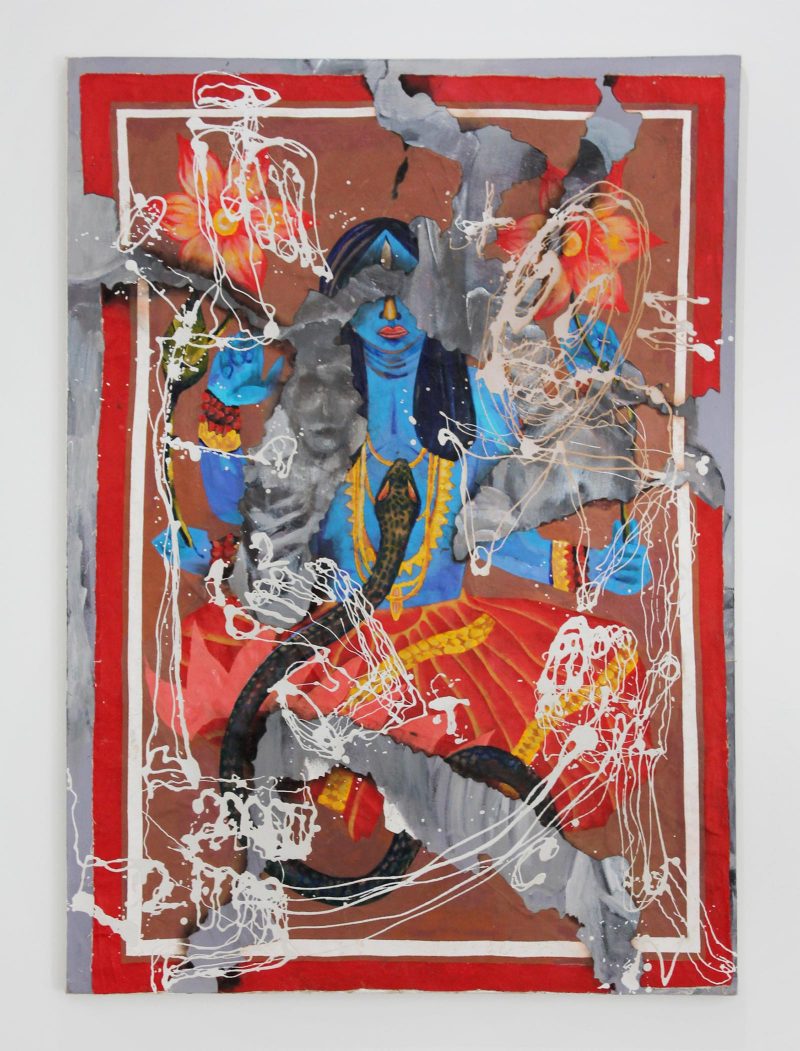
Even in “Puzzling Past, Takes Me Where?” – a painting which bears the least visual similarities with the others and altogether seems to belong to a different body of work – includes a skull. “Puzzling Past” put an end to my painterly reverie. A four-armed, blue-skinned Hindu deity, seated cross-legged facing a cobra, and surrounded by large red and yellow petaled flowers, is an unequivocal and powerful visual cue into the artist ‘s cultural background.
Bhattacharjee was born and brought up in Bangladesh. In the West, Bangladesh is often reduced to images of extreme poverty, sweatshops , dramatic loss of life from ferry incidents, and lately the Rohingya refugees’ camps and the inexorable rise of sea-level which in a couple of decades will affect more than 10% of the country’s surface area and endanger the lives of millions of Bangladeshis.
Excavation Paths, the title of the show curated by art historian Tausif Noor, highlights deeper recurring historical traumas confronted by Bangladesh and some of its neighboring countries. The image of the deity in “Puzzling Past” is torn, disfigured, besmirched. The tears reveal black and white moribund faces underneath.
The faces are based on a photograph of casualties of the famine which ravaged Bengal in 1943 killing an estimated three million people. In comparison, an estimated one million people died during the Great Irish Famine in the mid-nineteenth century. Although a century and thousands of miles apart, both famines were induced by the disastrous economic policies promoted by the British colonial government. The Bengal famine was followed four years later by yet another tragedy: the conflict which engulfed a large part of the sub-continent during the partition of British India. The partition saw an estimated 14 million people displaced and between 200,000 to two million killed.
The consequences of the Partition are omnipresent in the tensions between India and Pakistan and the sustained sectarian violence in the region. How not to see behind the tears, the drips and the defilement of “Puzzling Past, Takes me Where?” allusions to provocation and profanation, the hallmarks of religious intolerance.
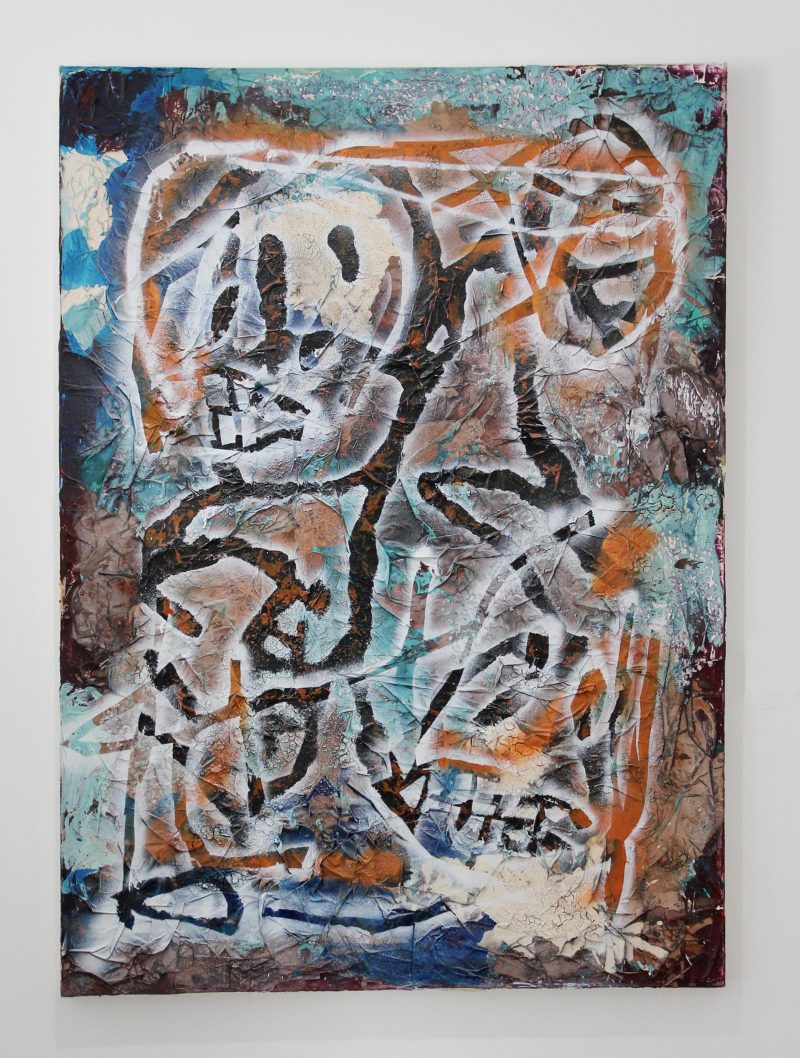
However, it is “History in My Land” that compels viewers to physically unpeel the long, rich, and complex history of Bangladesh. It is also in this work that the title of the exhibition finds its strongest expression. The entire surface of the painting is an intricate collage of folded and crumpled paper overlaid with white, orange, and blue acrylic or spray paint.
History can be complex. Behind the main chapter titles of the history books of any country like Bangladesh, hide a multitude of interconnected stories. The human cost and sacrifice often loom large on this history, much like the skulls emerging from the tortured surface in “History of My Land.” The paint craquelure visible all over the canvas is a reminder of the passing of time but also of the disastrous droughts that have afflicted Bangladesh.
“Oh My Rivers, Oh My Paths” is a clear allusion to the waterways of Bangladesh and the country’s unique coastal ecosystem known as the Sundarbans, a mangrove covering a wide area of exceptional biodiversity. The sinuous white lines flowing throughout the painting echo the extensive river system of Bangladesh. They also refer to the twisting path of the immigrant’s experience.
The South-Asian diaspora in the US, like all communities of color, is confronted with stereotypes and racism. These issues are very familiar to Twelve Gates Arts. They are in fact at the core of the gallery’s mission. Over the years Twelve Gates Arts, which specializes in exhibiting artists with roots in West and South Asia, has persistently explored artistic, societal, and political questions pertaining to this community. Parallels and awareness of these universal problems have been drawn in many shows organized by the Old City gallery, in particular the struggle of Black Americans for racial equality. Excavation Paths is no exception to this ongoing curatorial quest to encourage reflection and foster meaningful dialogue.
In “One Pot, one Body” painted in the aftermaths of the Black Lives Movement protests in Philadelphia and around the country, Bhattacharjee raises questions of identity. What is it to be an immigrant of color in a country plagued by centuries of racial injustice? What is the melting pot myth and why was it propagated?
The imposing four-legged creature is ambivalent. It conveys both strength through the body and death with its skulled head. Is this ominous creature a metaphor for the empty, failing, dying ideals of the melting pot? The body of the creature resembles a tiger, a recurring figure for the artist. The endangered Bengal tiger is the national animal of Bangladesh and naturally an important symbol.
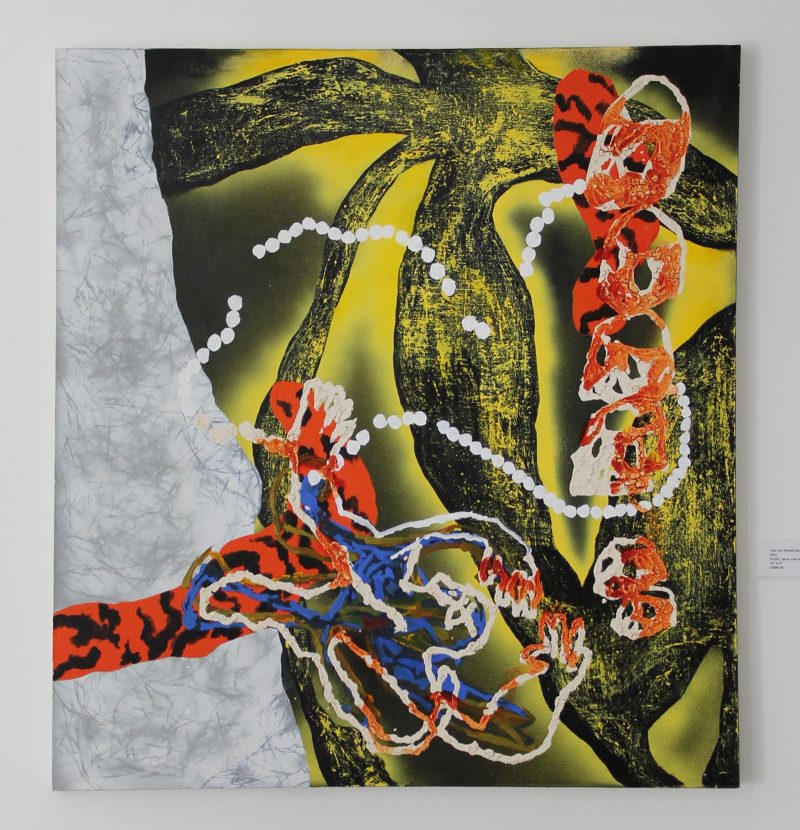
Despite careful observation I had missed the reference to the tiger in “Clue You Missed Along the Way.” A few steps backward and here it was, a depiction of an orange tiger tail with black markings stretching over two distinct surfaces. This last glimpse of the show, that of the tail of a furtive tiger, took me right back to my original impressions and my delight in observing Shwarga Bhattacharjee‘s skillfully rendered textured surfaces. Texture of feelings comes to my mind, an improbable concept in this context. But what is certain is that these works emanate from an artist who is deeply invested in using the possibilities of painting to investigate culture and history.
Like the tiger retreating into the wilderness, our feelings tend to slip away, often before we even catch sight of them. Painting is but one way to capture them. Bhattacharjee’s textured paintings are layered with meanings and feelings, some more buried than others. It is for you to look for them before the show closes February 23.
“Shwarga Bhattacharjee: Excavation Paths” is on view until Wednesday, February 23, 2022 at Twelve Gates Arts, 106 North 2nd Street, Philadelphia, PA 19106.


